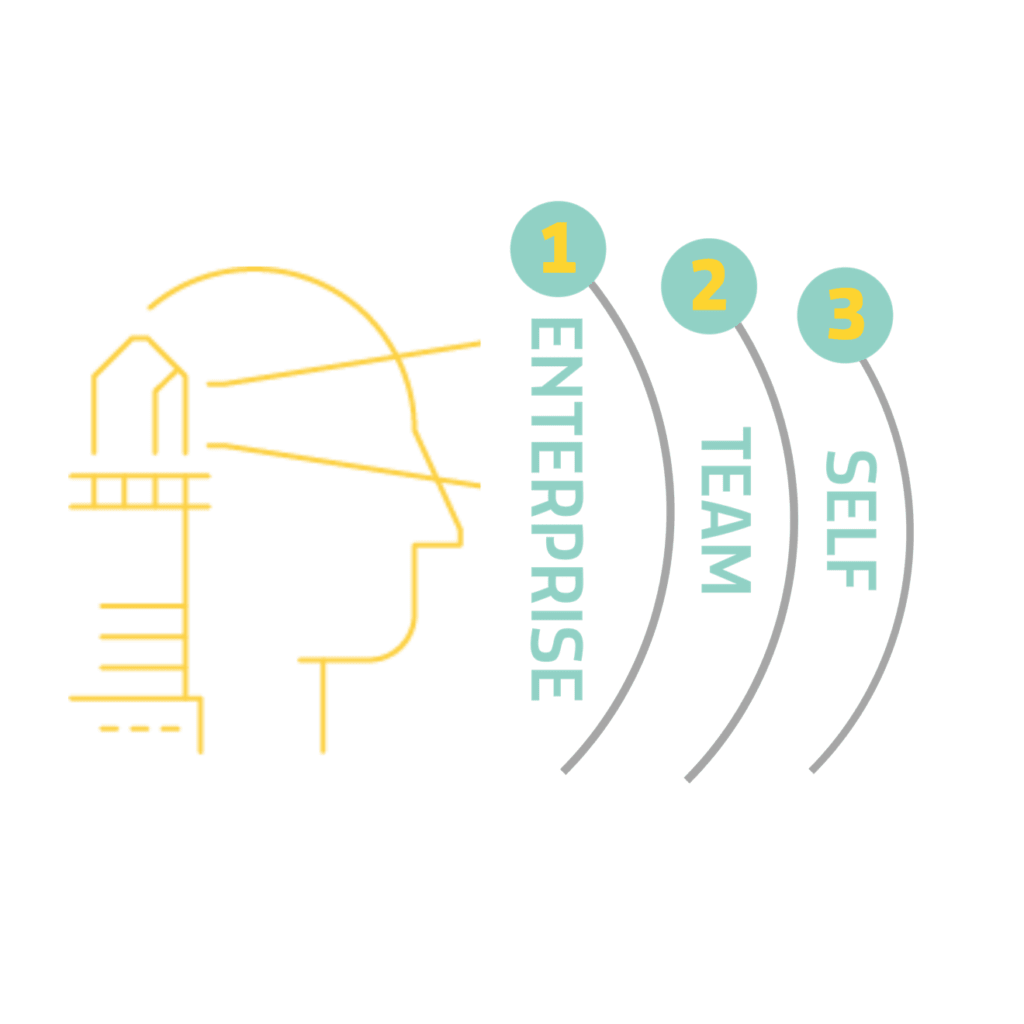
Turn Up Performance with Enterprise Collaboration and Empowered Decision-Making
There are a multitude of competing priorities that might keep executive leaders up at night, from talent engagement to business strategy, customer relationships, and much more. But our experience working with hundreds of C-suite executives over the course of two decades has shown that those with the discipline to see beyond real-time tactical challenges to examine the health of their enterprise dynamics will experience the most significant business performance outcomes over time.
Enterprise collaboration and empowered decision-making are two of the most overlooked and critically important dynamics that impact performance. Below, we’ve put together a guide to help you determine how your enterprise performance compares to those who excel in these two areas of focus, as well as processes you can put in place today to help you reach your performance goals.
Enterprise Collaboration
Healthy enterprise collaboration enables employees to share insights and expertise across specialties to generate exponential outcomes. When done well, enterprise collaboration will elevate engagement, ownership, retention, and innovation.
What does excellence look like?
From front-line employees to the C-suite, a consistent “enterprise-first” mindset with high transparency around what’s best for the business.
- A regular communication cadence that informs everyone of cumulative business performance and needs.
- A culture of collaboration to cultivate a shared drive to support one another across the organization.
- Expertise that is proactively shared to help fuel effective and productive collaboration.
- Strong business unit collaboration designed to ensure all teams accomplish their goals.
Most common challenges we see in this area:
- Complex handoffs from one business “silo” to another, without clear process and ownership.
- Distinct areas of operation critical to the long-range business strategy, with little proactive cross-collaboration.
- A lack of understanding and empathy for other areas of the business—i.e., a “not my problem” mindset.
- No structured collaboration process or cadence surrounding the customer experience.
- A “stay in your lane” operating style that promotes efficiency over innovation at all costs.
Mindset Matters in Enterprise Performance
Get started on the path to enterprise collaboration excellence by focusing on reframing your leaders to think with an enterprise-first mindset. We coach our clients to put the needs of the enterprise before their team and individual needs—enterprise, team, self.


“If you’ve worked in corporate America, you have likely experienced an inverted version of this continuum or one that is heavily weighted away from an enterprise-first mindset,” says Transcend CEO Craig Wiley for Forbes Coaching Council. “In this scenario, we’ve witnessed the loss of performance and competitive advantage when executives solve for teams or individuals at the expense of the enterprise.”
With the transition to an enterprise-first mindset, the other markers of “excellence” will begin to naturally fall into place, as business unit leaders will prioritize what’s best for the enterprise above their teams or themselves. Leaders will take on initiatives to engage in future-focused innovation, with their team and individual goals reflecting the mission and vision of the organization as a whole.
As the CEO takes on the task of redefining their executive’s primary team to be that of the enterprise rather than their business unit, collaboration within the executive team will accelerate and trickle down throughout the organization, creating a space where expertise is shared freely, allowing innovation and performance to thrive.
Decision Making in Enterprise Performance
Empowered decision-making is the most significant and frequently overlooked contributor to enterprise efficiency and alignment. Evaluating the effectiveness of your established decision-making processes will provide immediate enterprise value and deeper alignment across your executive team.
What does excellence look like?
- Decisions are openly communicated across the enterprise.
- The CEO encourages debate and dialogue within the executive team.
- Important decisions are rarely made in isolation.
- Team members feel empowered in their roles to make decisions for the enterprise.
- Data is transparently shared and utilized to inform decision-making.
Most common challenges we see in this area:
- A lack of structured decision-making processes or frameworks.
- A lack of a “post-mortem” process to debrief the outcomes of decisions made.
- No clarity or process around decision types and decision owners.
- A lack of transparency and openness to providing and receiving feedback within decision-making processes.
A Strategic Process
There are three types of decision-making processes that we find equally important to make an organization run efficiently and effectively. At one time or another, teams will use all three of these processes, but most importantly, all executive leaders should be clear and transparent about what type of decision-making process is being used and why. Below, we’ve outlined these three decision-making types and included situations where they might be best utilized to increase performance. Find out more about how to keep your team’s engagement intact during decision-making here.
Definitive Decisions
In some team dynamics, a decision needs to be made in isolation by an individual or small group. The decision owner(s) then share the final, definitive decision with the larger group. As a result, the group does not give feedback in hopes of informing a new decision, nor do they collaborate to change the decision. Instead, they support the process by seeking to understand the strategy behind the decision, then initiate the planning and execution of the project or task.
Reasons for using this type of decision-making process may include:
- A decision needs to be made urgently.
- The direction is clear.
- The decision is a result of a directive from other leaders in the organization.
Collective Decisions
In this process, a problem is presented to the entire team for a near-consensus decision. The team is encouraged to challenge the pros and cons of different options and collectively agree on the appropriate strategic direction. A decision is made once a majority of the team members have agreed upon a way forward. This tactic should be used sparingly, as it is the most time-consuming and resource-intensive type.
Reasons for using this type of decision-making process may include:
- High-stakes decisions.
- The decision will impact multiple business units throughout the enterprise.
- It is a low-risk opportunity to engage the broader organization.
Informed Decisions
Informed decisions leverage the power of feedback to educate a decision owner. In this process, the decision owner collects input from the larger team and determines a course of action based on all the information they have received. The team will act as advisors and trust the owner to decide on the best way forward.
Reasons for using this type of decision-making process may include:
- The decision will impact the entire enterprise.
- It would increase engagement by ensuring key business unit owners have a voice.
- When collecting critical insights would minimize potential blind spots.
The type of decision-making process you choose is critical; however, even more important is how well you can communicate your approach to the organization. Preparing your teams for where and how they will best contribute is essential. Once this becomes the standard practice, your organization can operate most effectively.
Ask yourself: How would you rate the health of your organization in the areas of enterprise collaboration and decision-making? Executive leaders who are able to streamline these two areas will find it much easier to execute the tactical side of their role, as the energy around tactical challenges will be brimming with collaboration and shared ownership. Performance and engagement will also increase, allowing the executive critical time and flexibility to focus on the future of the business strategy and success. You can learn more about how these two dynamics fit within our larger model of enterprise performance and how to implement them as a leader in this Forbes article from Transcend’s CEO Craig Wiley.
Transformation begins with small changes that accumulate to create big wins. Are you ready to take on the task of changing the collective mindsets and processes that will take your business performance to the next level?

